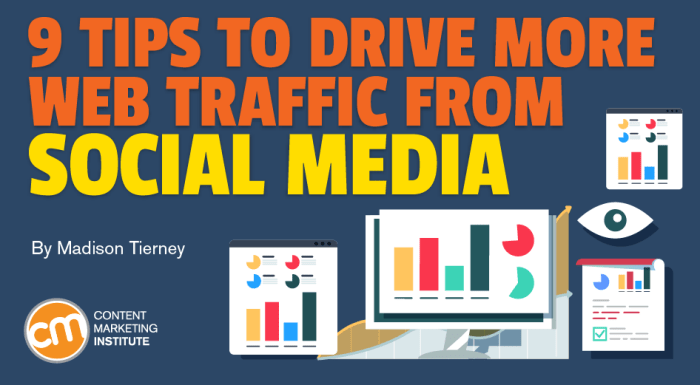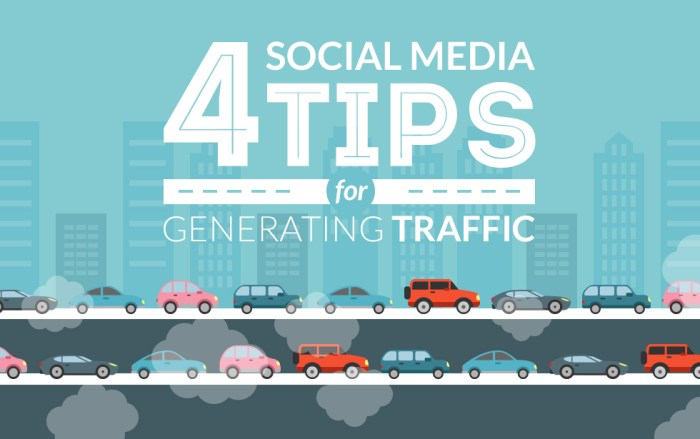Generating Traffic with Social Media sets the stage for boosting website traffic through engaging strategies and platform utilization, unveiling the keys to success in the digital realm.
Explore the dynamic world of social media traffic generation and discover the tactics and tools needed to thrive in the online landscape.
Importance of Social Media for Traffic Generation
Social media plays a crucial role in driving traffic to websites by providing a platform for businesses to connect with their target audience, increase brand visibility, and promote their products or services. With the vast number of users on social media platforms, businesses have the opportunity to reach a larger audience and drive traffic to their websites effectively.
Yo, if you’re looking to boost your website’s search engine game, you gotta be all about that SEO Analytics Tools life, ya know? Check out this dope article on Using SEO Analytics Tools to stay ahead of the curve and keep your online presence poppin’ like whoa.
Examples of Successful Businesses
- 1. Nike: Nike has successfully utilized social media platforms like Instagram and Twitter to engage with their followers, showcase their latest products, and drive traffic to their online store.
- 2. Airbnb: Airbnb has leveraged social media to connect with travelers, share user-generated content, and drive traffic to their website for bookings.
- 3. Glossier: Glossier has built a strong community on social media platforms like Instagram and TikTok, encouraging user-generated content and driving traffic to their e-commerce site.
Impact of Social Media Algorithms
Social media algorithms play a significant role in determining the visibility of content and ultimately affecting traffic generation. The algorithms prioritize content that receives high engagement, such as likes, comments, and shares, making it crucial for businesses to create engaging and relevant content to reach their target audience effectively.
Strategies for Generating Traffic with Social Media

In today’s digital age, leveraging social media platforms is crucial for increasing website traffic. Here are some effective strategies to help you make the most out of your social media presence:
Leverage Multiple Platforms
Utilize a variety of social media platforms to reach a wider audience. From Facebook and Instagram to Twitter and LinkedIn, each platform offers unique opportunities to engage with users and drive traffic to your website.
Yo, if you’re looking to step up your digital marketing game, you gotta get on that SEO analytics tools grind. Check out this article on Using SEO Analytics Tools for real insights on how to boost your online presence and get that traffic flowing. Don’t sleep on this, fam!
Create Compelling Visual Content
Visual content such as images, videos, and infographics tend to perform better on social media. Create eye-catching visuals that are relevant to your brand and encourage users to click through to your website for more information.
Engage with Your Audience
Interacting with your followers through comments, messages, and shares can help build a loyal community around your brand. This engagement not only increases brand awareness but also drives traffic to your website as users become more interested in what you have to offer.
Run Contests and Giveaways
Contests and giveaways are a great way to generate buzz around your brand and encourage users to visit your website. By offering prizes or discounts, you can incentivize users to engage with your content and ultimately drive more traffic to your site.
Utilize Influencer Marketing
Partnering with influencers in your niche can help expose your brand to a larger audience and drive traffic to your website. Influencers can promote your products or services to their followers, increasing brand visibility and generating more website visits.
Paid Advertising vs. Organic Methods
While paid advertising can deliver immediate results, organic methods such as creating engaging content and building relationships with your audience can yield long-term benefits. It’s important to strike a balance between the two approaches to maximize your traffic generation efforts.
Measure and Analyze Performance
Tracking key metrics such as click-through rates, engagement levels, and website traffic sources can help you understand what strategies are working and where you need to make adjustments. Use analytics tools to monitor your performance and optimize your social media strategy accordingly.
Utilizing Different Social Media Platforms: Generating Traffic With Social Media
When it comes to generating traffic with social media, utilizing different platforms is key to reaching a wider audience and driving more visitors to your website. Each social media platform has its own strengths and target audience, making it important to choose the right ones for your specific industry or niche.
Best Social Media Platforms for Specific Industries
- Facebook: Ideal for businesses in various industries due to its large user base and diverse demographics.
- Instagram: Great for industries that rely heavily on visual content like fashion, beauty, and travel.
- Twitter: Effective for industries that thrive on real-time updates and engaging with a younger audience.
- LinkedIn: Perfect for B2B industries and professionals looking to connect and network within their niche.
- Pinterest: Ideal for industries focused on DIY, home decor, recipes, and anything visually appealing.
Differences in Platforms for Traffic Generation
- Facebook: Allows for longer posts, videos, and targeted advertising to reach specific audiences.
- Instagram: Emphasizes visual content through photos and videos, with a focus on aesthetics and storytelling.
- Twitter: Limited to 280 characters per tweet, making it ideal for brief updates, links, and engaging with followers in real-time.
- LinkedIn: Geared towards professional networking, sharing industry insights, and connecting with like-minded individuals.
- Pinterest: Focuses on visual discovery, making it perfect for showcasing products, DIY projects, and inspiring ideas.
Role of Visual Content on Instagram and Pinterest
Visual content plays a crucial role on platforms like Instagram and Pinterest as they are highly visual-centric platforms. Eye-catching images and videos are more likely to grab users’ attention and encourage them to click through to your website. Utilizing high-quality visuals that align with your brand and resonate with your target audience can significantly increase traffic and engagement on these platforms.
Metrics and Analytics for Social Media Traffic

When it comes to analyzing traffic generated from social media platforms, it’s crucial to track key metrics that can provide valuable insights into the effectiveness of your strategies. By monitoring these metrics, you can make data-driven decisions to optimize your social media traffic and improve your overall performance.
Key Metrics to Track
- Engagement Rate: Measure the level of interaction your content receives, such as likes, comments, and shares.
- Click-Through Rate (CTR): Track the percentage of users who click on your links or ads to visit your website.
- Conversion Rate: Monitor the rate at which social media traffic converts into leads, sales, or other desired actions.
- Reach and Impressions: Evaluate the number of people who see your content and how many times it’s displayed.
- Referral Traffic: Analyze the amount of traffic coming to your website from social media platforms.
Dashboard Template for Monitoring Metrics
Creating a dashboard template can help you visualize and track your social media traffic metrics effectively. Here’s a step-by-step guide on how to set up a dashboard:
- Choose a tool or platform for building your dashboard, such as Google Analytics, Data Studio, or social media management tools.
- Select the key metrics you want to monitor and customize your dashboard layout accordingly.
- Organize your metrics into different sections for easy navigation and analysis.
- Set up data visualizations, such as graphs, charts, and tables, to display the metrics in a clear and concise manner.
- Regularly review and update your dashboard to ensure you’re tracking the most relevant metrics for your social media traffic.
Setting Up Conversion Tracking, Generating Traffic with Social Media
Conversion tracking is essential for measuring the impact of your social media traffic on your business goals. Follow these steps to set up conversion tracking effectively:
- Define your conversion goals, such as form submissions, purchases, or sign-ups, that you want to track from social media traffic.
- Use tracking pixels or codes provided by social media platforms to monitor user actions on your website accurately.
- Integrate your tracking codes with your website or landing pages to capture data on conversions driven by social media traffic.
- Analyze the conversion data to identify trends, optimize your campaigns, and improve your overall social media strategy.
